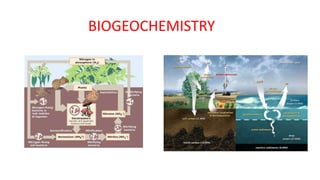
Biogeochemistry Introductory Slides
- 2. What is Biogeochemistry? • The study of the biological, geological and chemical factors that influence the movement of chemical elements through living systems across space and time. • Processes can be studies at the microbial, ecosystem and global scales • Scales are becoming increasingly integrated. • Ex: The role of microorganisms in carbon cycling and global climate change • Elements “cycle” through reservoirs often termed as source or sink • Matter of perspective and what is being measured • Ex. Plant biomass is a sink of atmospheric carbon (CO2) via photosynthesis Burning of fossil fuels (i.e. dead plants) is a source of carbon to the atmosphere
- 4. Four main elemental cycles • Carbon (C) • Nitrogen (N) • Phosphorous (P) • Sulfur (S) • Elements do not cycle independently. • Ex: Denitrification (N03 N2) requires C that is easily consumed by microbes
- 5. Carbon Cycle Short Term Storage Long Term Storage Significant Microbial Component Notice: natural processes of photosynthesis and respiration are nearly equal if not slightly in favor of storage in biota, soils, and ocean surface water UNITS! Gigatons C/Year
- 6. Nitrogen Cycle Critical microbial components at all stages. Highly abundant form of N. Inaccessible to most organisms due to the triple bond between N atoms. Primarily rely on nitrogen fixing bacteria to introduce bioavailable N to ecosystems. (Note: Some trees can fix N due to symbiotic relationship with bacteria.) Main mechanism in which nitrogen is removed from ecosystems DON
- 7. Sulfur Cycle Important microbial component Concern of acid rain via Industrial Processes
- 8. Phosphorous Cycle No gaseous phase Weathering of rock is the original source of P Important microbial component
- 9. Isotopes: a powerful technique in Biogeochemistry • Isotopes: atoms of the same element that vary in atomic mass due to different number of neutrons • Two most common in Biogeochemistry research • Carbon: 12C, 13C Nitrogen: 14N, 15N • Different reservoirs have isotopic signatures • Plants: higher 13C:12C than the atmosphere • Nitrogen in the ocean: higher 15N:14N signature than terrestrial bound nitrogen • Organisms higher on the food chain have higher 15N values • Vegetarian/vegans have lower 15N values }Research implications?
- 10. Two main isotopic techniques • Relative Abundance: measure isotopic ratios to determine if something is changing • Ex: The ratio of atmospheric 13C:12C is increasing indicating more plant-based carbon is entering the atmosphere • What is the source of this new plant-based carbon? • Stable Isotopes: Raise the amount of the rarer isotope way above background levels and follow it through a system • Ex:15N can be added to a stream and measured downstream to determine the demand for N by microorganisms.
Editor's Notes
- Nitrogen Cycle Slide: https://en.wikipedia.org/wiki/Nitrogen_cycle#/media/File:Nitrogen_Cycle.svg Carbon Cycle Slide: http://earthobservatory.nasa.gov/Features/CarbonCycle/ (Diagram adapted from U.S. DOE, Biological and Environmental Research Information System.)
- United States Department of Energy "Simplified Global Carbon Cycle," http://genomics.energy.gov (accessed October 2, 2013) Required element for all life forms. Organisms use C to build biomass and create usable chemical energy (ATP). Carbon in the atmosphere is a greenhouse gas especially in the forms of CO2 and CH4 which result from the respiration and combustion of carbon-based compounds. These greenhouse gases help keep the biosphere warm and habitable; too much traps too much heat and is a driving factor in global climate change.
- http://en.wikipedia.org/wiki/Nitrogen_cycle (Accessed: October 2 2013) and adapted by A Wymore Nitrogen is a required compound for life. Can serve as an electron acceptor for metabolic processes and is a required element to build proteins, enzymes and nucleic acids (e.g. DNA). Too much nitrogen in an ecosystem can release certain organisms from N limitation causing negative ecosystem effects such as eutrophication (e.g. red tides, harmful algal blooms). Excess nitrogen has been added to ecosystems in recent decades due to atmospheric deposition via industrial processes and intensive and industrial use of fertilizers.
- Source: https://commons.wikimedia.org/wiki/File:SulfurCycle_copy.jpg Sulfur is one of the most abundant elements on Earth Sulfur is a required element for all organisms: essential element in proteins Concern of anthropogenic sulfur dioxide and sulfur oxides and the production of acid rain and snow precipitation
- http://reefkeeping.com/issues/2006-08/cj/index.php (Accessed: October 7, 2013) Phosphorous is an essential element for organisms. Required in DNA and RNA the genetic and heritable material of cells. Often a limiting nutrient in ecosystems. Especially in “older” ecosystems where the bedrock has experienced prolonged weathering (e.g. eastern forests of North America) Because it limits growth, P is often added as fertilizer including at the industrial scale. Runoff can cause eutrophication of aquatic ecosystems.